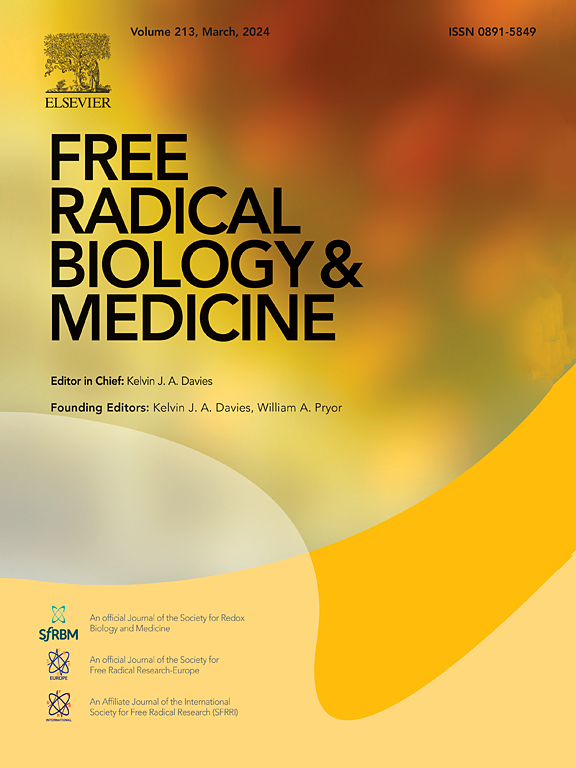确定细胞色素 P450 2E1 为神经炎症的新靶点并开发其抑制剂 Q11 作为治疗策略
IF 7.1
2区 生物学
Q1 BIOCHEMISTRY & MOLECULAR BIOLOGY
引用次数: 0
摘要
神经炎症几乎涉及中枢神经系统(CNS)疾病的所有病理过程。然而,临床上没有专门针对神经炎症的药物,传统的抗炎药物疗效有限。在这里,我们确定了细胞色素P450 2E1 (CYP2E1)作为神经炎症的新治疗靶点。在小鼠和大鼠神经炎症模型的海马组织以及lps刺激的初级小胶质细胞中观察到CYP2E1水平升高。基因消融Cyp2e1可改善神经炎症大鼠的空间学习和记忆,并降低Cyp2e1缺失小胶质细胞的促炎细胞因子水平。此外,本实验室开发合成的CYP2E1抑制剂Q11(1-(4-甲基-5-噻唑基)乙烯酮)可有效改善小鼠/大鼠阿尔茨海默病相关空间学习记忆功能和抑郁相关焦虑样行为。在机制上,Q11通过抑制PI3K/Akt、STAT1/3和NF-κB信号通路减轻小胶质细胞活化、神经元损伤、氧化应激和神经炎症。这些发现确立了CYP2E1是神经炎症的可药物靶点,并提出Q11是治疗神经炎症相关疾病的有希望的候选者。本文章由计算机程序翻译,如有差异,请以英文原文为准。

Identification of cytochrome P450 2E1 as a novel target in neuroinflammation and development of its inhibitor Q11 as a treatment strategy
Neuroinflammation is implicated in nearly all pathological processes of central nervous system (CNS) diseases. However, no medications specifically targeting neuroinflammation are clinically available, and conventional anti-inflammatory drugs exhibit limited efficacy. Here, we identified cytochrome P450 2E1 (CYP2E1) as a novel therapeutic target in neuroinflammation. Elevated CYP2E1 levels were observed in hippocampal tissues of mouse and rat neuroinflammation models, as well as in LPS-stimulated primary microglia. Genetic ablation of Cyp2e1 improved spatial learning and memory in neuroinflammatory rats and reduced pro-inflammatory cytokine levels in Cyp2e1-deficient microglia. Furthermore, Q11 (1-(4-methyl-5-thiazolyl) ethanone), a novel CYP2E1 inhibitor developed and synthesized in our laboratory, effectively ameliorated Alzheimer's disease-related spatial learning and memory functions and depression-related anxiety-like behaviors in mice/rats. Mechanistically, Q11 attenuated microglial activation, neuronal damage, oxidative stress, and neuroinflammation by suppressing the PI3K/Akt, STAT1/3, and NF-κB signaling pathways. These findings establish CYP2E1 as a druggable target for neuroinflammation and propose Q11 as a promising candidate for treating neuroinflammation-related diseases.
求助全文
通过发布文献求助,成功后即可免费获取论文全文。
去求助
来源期刊

Free Radical Biology and Medicine
医学-内分泌学与代谢
CiteScore
14.00
自引率
4.10%
发文量
850
审稿时长
22 days
期刊介绍:
Free Radical Biology and Medicine is a leading journal in the field of redox biology, which is the study of the role of reactive oxygen species (ROS) and other oxidizing agents in biological systems. The journal serves as a premier forum for publishing innovative and groundbreaking research that explores the redox biology of health and disease, covering a wide range of topics and disciplines. Free Radical Biology and Medicine also commissions Special Issues that highlight recent advances in both basic and clinical research, with a particular emphasis on the mechanisms underlying altered metabolism and redox signaling. These Special Issues aim to provide a focused platform for the latest research in the field, fostering collaboration and knowledge exchange among researchers and clinicians.
 求助内容:
求助内容: 应助结果提醒方式:
应助结果提醒方式:


